Pros
-
No brightness fluctuations even on full-white screens
-
Vivid, accurate color
-
Packed with ports and quality-of-life features
Cons
-
Might be too large for some
About the Alienware AW3225QF
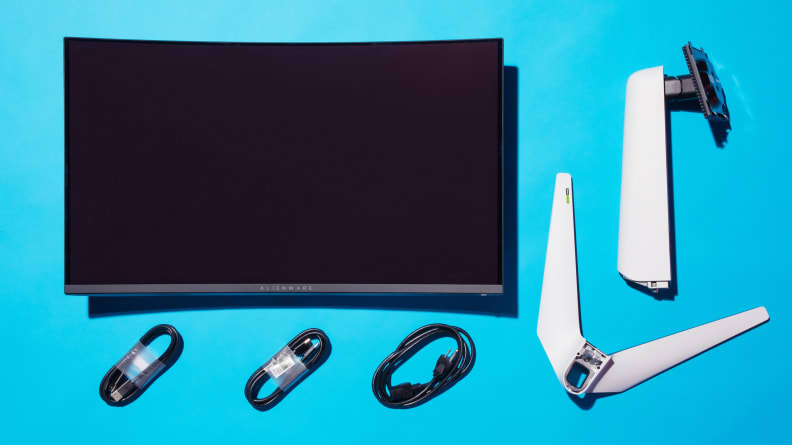
The Alienware AW3225QF skips the bulky power brick commonly found on other gaming monitors.
The Alienware AW3225QF is the first gaming monitor to hit the market with Samsung’s third-generation QD-OLED panel, and the first 4K, 240Hz OLED display at 32 inches to go on sale to the public at the time of writing. It launched alongside the Alienware AW2725DF, the first 27-inch, 1440p, 360Hz QD-OLED gaming monitor.
On paper the AW3225QF doesn’t seem like a major upgrade over Alienware’s previous QD-OLED monitor, the 34-inch AW3423DW. Both boast a 250-nit peak brightness in SDR and 1,000 nits when HDR is enabled, but that doesn’t tell the whole story, and the final product wowed us so much at CES that we named it a CES 2024 award winner. The AW3225QF is capable of maintaining a full-screen brightness of well over 200 nits on an all-white screen and doesn’t fluctuate in brightness depending on the content being displayed, an issue that plagued last-gen OLED monitors. Additionally, gamers who were disappointed that OLED gaming monitors on the market were previously only available with matte finishes will be pleasantly surprised to find a glossy anti-glare coating on the AW3225QF.
The AW3225QF is also the first gaming monitor with Dolby Vision HDR support, though the number of PC games that support this standard is low. Instead, that feature remains better suited for consoles and Alienware has acknowledged that potential by adding eARC support to the monitor, allowing for a more TV-like experience.
Alienware AW3225QF specs
- Price: $1,200
- Display size: 32 inches
- Resolution: 3840 x 2160 pixels
- Refresh rate: 240Hz
- Peak brightness: 250 nits (rated), 1,000 nits peak with HDR enabled (rated); 260 nits (SDR, tested at 10% window), 429 nits with HDR enabled (10% window, tested), 903 nits with HDR enabled (3% window, tested)
- HDR support: VESA Display TrueBlack HDR400
- Color depth: 10-bit
- Color saturation: 99.3% DCI-P3 (rated); 100% sRGB (tested), 98.2% DCI-P3 (tested), 92.7% AdobeRGB (tested)
- Contrast ratio: 1,500,000:1 (rated)
- Pixel response time (GtG): 0.03ms
- Ports: 2x HDMI 2.1 (1x with eARC support), 1x DisplayPort 1.4, 3x USB-A 3.2 gen 1 ports, 1x USB-B 3.2 Gen 1 (upstream), 1 x USB Type-C (downstream only, Battery Charging 1.2 power delivery)
- VRR Support: VRR, AMD FreeSync Premium Pro, G-Sync compatible
- Other features: Integrated USB hub, integrated power board design, anti-glare coating, 1700R curve, Dolby Vision HDR, 3-zone customizable AlienFX lighting, HDMI eARC/ARC port, Kensington lock, picture-in-picture mode, VESA mount compatible (100x100)
- Warranty: 3-year advanced exchange service warranty (including OLED panel burn in)
What we like
Color reproduction and accuracy are stunning
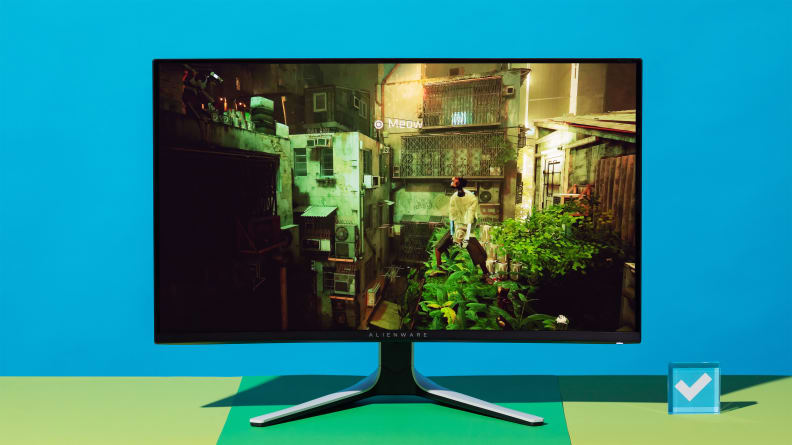
The deep, rich contrast and vivid colors lend moodier games more atmosphere.
The Alienware AW3225QF is without a doubt one of, if not the best-looking gaming monitors we’ve ever tested. Even on the standard image setting preset that it comes pre-configured with out of the box, I was impressed at how much mundane tasks, like browsing the Steam storefront, popped. Red tones are especially vibrant when compared to an IPS display.
Whether playing games or watching content, both are rendered in excellent clarity. It really can’t be overstated how vibrant colors are on the AW3225QF thanks to the quantum dot layer Samsung applies over the OLED panel. It’s not new technology, but if you’ve only used an IPS, VA, or even WOLED display before (LG’s OLED panel type that adds a white subpixel to the traditional red, green, and blue to boost brightness), the difference will be stark.
As with any other OLED display, the AW3225QF packs fantastic contrast, too. It’s inherent to the technology, as each pixel emits its own light rather than relying on a backlight, meaning each can turn off when not in use to produce perfect black levels. That means there’s no bloom when bright objects are displayed alongside darker ones no matter how fast they’re moving, but also that contrast is effectively infinite. Dark scenes feel rich and deep, retain all of their detail, and exhibit no smearing or blurring.
Color accuracy is some of the best we’ve recorded on a gaming monitor, and we documented similar results on the AW2725DF. After calibrating the AW3225QF, I measured an astounding average DeltaE—the difference between a target color value and what’s actually recorded—of only 0.57, and a maximum DeltaE value of 1.36. For context, the untrained eye can detect differences above 2, and a DeltaE of below 1 is generally good enough for color-sensitive work. Viewing angles are just as good, with no shifting no matter where the display is seen from.
It’s fast and sharp
Aside from deep, rich blacks, OLED displays provide, they also have very fast pixel response times. This means being able to track fast-moving objects without any blurring or smears, whether it’s in games like The Finals or on Blur Busters’ UFO test. Enemies and everything else glide across the screen without losing an ounce of detail. The AW2725DF offers slightly better motion clarity thanks to its 360Hz refresh rate, but most people won’t be able to tell.
Earlier OLED monitors (including the Alienware AW3423DW) suffered from a slight color fringing effect around text because OLED displays use a different subpixel arrangement than LCD displays. Although the problem isn’t totally remedied here, the AW3225QF has a high enough pixel density (137 pixels per inch, versus 108 for a 27-inch, 1440p monitor) that it’s hardly noticeable. I tested this monitor with 150 percent UI scaling set in Windows 11 and only detected color fringing if I put my face about six inches from the display.
Speaking of the resolution, the additional pixel density and size gel well in games where you want to focus on tiny, intricate details. Deck-building titles Hearthstone or Magic: The Gathering Arena benefited the most in our testing.
No more dim whites

Text fringing is largely unnoticeable unless very close.
My biggest complaints about OLED gaming monitors have both involved brightness. I like to run my monitors on the bright side since my desk is next to a window, and until now, OLED monitors like the Corsair Xeneon 27QHD240 (which I specifically lauded for its productivity features) dimmed quite a bit when all-white content like Word documents or spreadsheets were on-screen. They also tended to rapidly dim when displaying brighter content and brighten when showing darker content to help prolong the life of the OLED panel, making them unsuitable for color-accurate work since they couldn’t maintain a consistent brightness level and were plain annoying to use daily.
That’s been (nearly) remedied on the AW3225QF. It’s an OLED monitor I would confidently use for work as well as gaming—and have been for weeks, without issue. After setting the display up, I settled in at 83 percent brightness, because 100 percent was too bright to use comfortably. I measured 220 nits with a full white screen at maximum brightness, which doesn’t sound like a lot, but subjectively it appears much brighter—running this monitor side-by-side with my secondary display set to 250 nits, and the AW3225QF felt brighter due to the better contrast.
There is some dimming as different objects are displayed, but often not enough to be noticeable. For instance, a pure white box measuring 10 percent of the screen size set against a black background measured 260 nits instead of the aforementioned 220. The darker background around my canvas in Photoshop tends to flicker a bit as the display dims around the brighter content, but it is a minor effect.
HDR is exceptional

Games that support HDR are capable of delivering blindingly realistic highlights.
HDR performance is a major selling point, and the AW3225QF delivers as promised. In fact, it’s the only gaming monitor I’ve seen where you could conceivably do your day-to-day work with HDR enabled, and I suspect some people will just leave it on all the time. Switching the Dolby Vision mode to dark, I recorded an average DeltaE value of just 0.93 for sRGB content with HDR enabled.
But although the AW3225QF delivers a good HDR experience on the desktop, that’s not really the point of the feature. Suffice to say, games and movies with HDR support look fantastic when it’s enabled. As is typical with OLED displays, dark, shadows look appropriately moody and detailed without getting crushed as they might in monitors with a lesser contrast ratio. Lifelike color is a given, but when you combine that with punchy highlights, it all comes together in an especially impressive way. Staring into a dusky desert sunset in Horizon Zero Dawn, exploring the Underdark in Baldur’s Gate 3, or any other game where the environment rapidly shifts between dark and light areas looks particularly evocative.
Although there are only about three dozen PC games that support Dolby Vision at the time of writing, it adds an additional secret trick to those select few games; brightness. In Returnal, the dark jungles and biomechanical ruins of Atropos are appropriately foreboding, but the laser grids, enemy projectiles, and Selene’s energy sword pop with an eye-searing intensity without dimming the rest of the display. They can co-exist with each other on-screen, delivering an experience closer to what you might find on a mini-LED display. Menu and HUD text is also a vibrant white, not a dull gray like it can be on some HDR displays with poor contrast. It’s impressive tech and I hope more games adopt it.
The design is well thought out
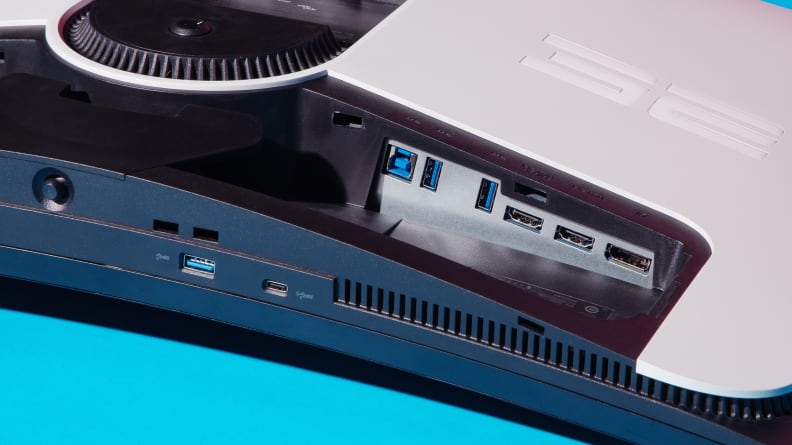
A USB-A and USB-C port are located on the monitor's underside next to the navigation joystick.
Alienware paid attention to detail with the AW3225QF, and it packs a number of quality-of-life features I would be heartened to see on other monitors moving forward. First and foremost, there’s no power brick despite the monitor’s max rating of 190 watts.
The stand is rock solid and well-designed, with a cable routing hole for keeping your cords organized and an included backplate for tucking everything out of sight once they’re plugged in. It offers a surprising amount of tilt in either direction and easily slides up and down. Jostling my desk or typing didn’t move the panel at all. I usually test a monitor’s stand and then stick it on an arm, but with the stand’s cable routing, I didn’t bother with the AW3225QF.
If I had wanted to decouple the panel from the stand, all I would have had to do was press a button to pop it off. The gamer-y aesthetic is admittedly a poor fit for an office setting, but at least you can disable the RGB lighting on the back.
There are also enough USB ports on board to accommodate a host of peripherals. The USB-A and USB-C ports on the bottom of the monitor are handy and provide quick access, but also might prove annoying to finagle if you keep the monitor at the lowest height setting like I do. It’s also unfortunate that the AW3225QF lacks the ability to take video input over USB-C, but at least Dell provides a USB-C-to-DisplayPort cable for MacBook or Steam Deck users who want to dock their devices to it.
What we don’t like
32 inches might be a bit too large for some
The Alienware AW3225QF might be just the right size for productivity, and the slightly curved edges do more to guide your vision towards what’s on-screen than distract, but 32 inches might be a tad too large for some people. If you mainly play first-person shooter games where you need to keep an eye on the periphery for enemies or you’re hurting for desk space, then the Alienware AW2725DF might be a better fit.
Typical Windows issues with 4K displays

Pixel density isn't quite retina display-quality, but it lends games with more intricate details more depth.
This is less of an issue with the AW3225QF itself and more of a Windows 10/11 gripe, but I ran into my share of (standard) issues during testing. Don’t expect Windows to play nicely with scaling different UI elements across multiple displays if you have more than one monitor. I also ran into an issue where the maximum refresh rate dropped to 120Hz and wouldn’t go higher, but this ultimately resolved itself. It was likely a signal integrity issue, which makes sense as pushing 4K at 240Hz uses a lot of bandwidth.
Additionally, most users won’t be able to hit the maximum 240Hz this monitor can output at native resolution anyway unless they’re equipped with a Nvidia RTX 4090. My trusty Asus ProArt 4070 Ti struggled to maintain a smooth framerate until I enabled DLSS in heavier games like Alan Wake 2 or Baldur’s Gate 3.
That said, these are caveats of any 4K monitor and you might decide the additional pixel density is worth it.
Dolby Vision doesn’t always play nice with games
Alienware touts the AW3225QF as the first Dolby Vision HDR-certified gaming monitor on the market. It’s a nice feature to have, but at the time of writing, less than two dozen PC games support it. If you’re a console gamer, that’s great, you’ll find that the same titles you’ve enjoyed on your Dolby Vision-certified TV will look just as good (or better, depending on your setup) here.
But if you’re playing a game in HDR that doesn’t support Dolby Vision, there’s an annoying hiccup. The desktop plays nicely when it’s turned on and is bright and crisp, but if a game doesn’t support it, expect to see the screen brighten and the “DOLBY VISION” logo flash in the upper corner of the monitor if system elements like your volume bar or Slack notification pop up.
Should you buy the Alienware AW3225QF?
Yes, it might be the best gaming monitor on the market
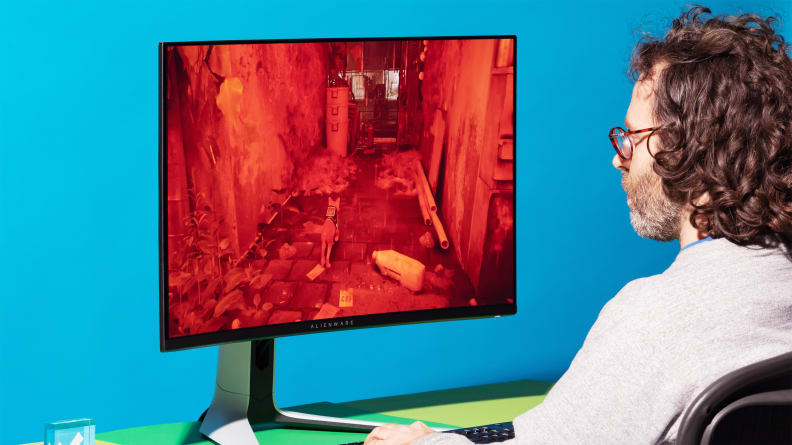
32 inches might be too large for some, but games uniformly look great and feel good to traverse.
There are only a few reasons you might want to avoid buying the Alienware AW3225QF: it’s too expensive, you’re happy with your current monitor, or 32 inches is too large for your use case. If you can afford the $1,200 price and the desk space, however, it’s no contest.
Curved monitor skeptics might want to wait for the forthcoming Samsung Odyssey OLED G80SD (though it will have a matte finish) or the Omen Transcend 32, as both will use the same 32-inch, 4K, 240Hz QD-OLED panel. I was also wary, but after using the AW3225QF for three weeks, I often forgot the slight 1700R curve was even there. If you want an OLED gaming monitor but $1,200 is too much to spend, the Alienware AW2725DF might be the better option at $900. For the value, both of these new Alienware monitors provide—including the 3-year burn-in warranty—we recommend staying away from last-generation WOLED gaming monitors like the LG UltraGear OLED 27GR95QE-B or Corsair Xeneon 27QHD240 unless you can find them on deep discount.
I can’t bang this drum hard enough; the Alienware AW3225QF is the best-looking gaming monitor I’ve ever set eyes on. If you can afford it, it’s a no-brainer.
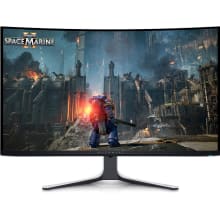
The Alienware AW3225QF is a blazing-fast 32-inch, 4K QD-OLED gaming monitor with fantastic color and pixel response times.
Meet the tester
Jonathan is an Electronics Editor for Reviewed specializing in gaming gear and has experience with everything from controllers to benchmarking the latest GPUs. He was previously the Web Editor at The Architect's Newspaper.
Checking our work.
Our team is here for one purpose: to help you buy the best stuff and love what you own. Our writers, editors, and lab technicians obsess over the products we cover to make sure you're confident and satisfied. Have a different opinion about something we recommend? Email us and we'll compare notes.
Shoot us an email





